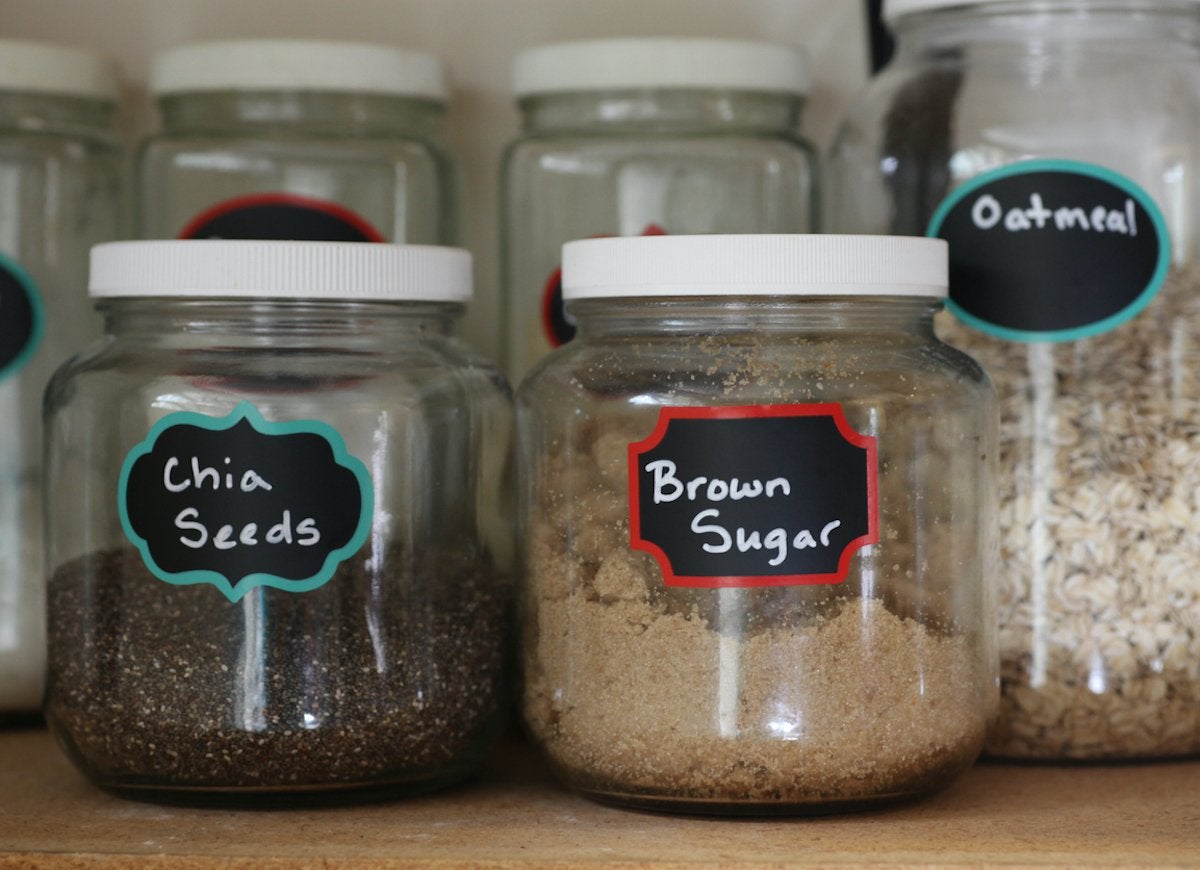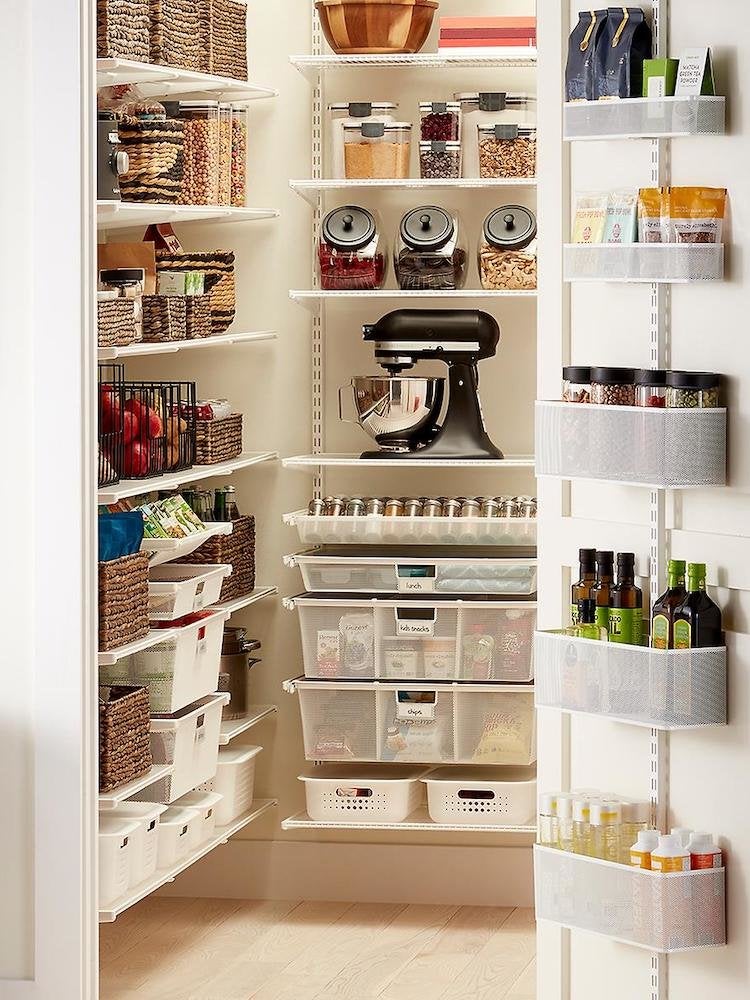

We may earn revenue from the products available on this page and participate in affiliate programs. Learn More ›
Let's Get Organized

If the kitchen is the center of the home, the pantry is the center of the kitchen. Having an organized pantry makes everything that happens in the kitchen easier; you have quicker access to the supplies you need and can clearly see the items you need to repurchase. There are so many ways to make the most of your pantry space no matter its size: baskets, bins, drawers, and containers of every type. Use our favorite pantry organization tips to help you design the pantry of your dreams.
Pegboard

A pegboard (which you can buy from The Container Store) has long been a popular storage option in kitchens. It’s also great in the pantry—use it to cover an empty wall to collect pots, pans, colanders, and other utensils to free up space on the shelves for other goods. If you have the supplies on hand, you can up the look and paint it to match your kitchen decor.
Mason Jars

Mason jars are a practical and beautiful way to help organize foodstuffs. They come in sizes appropriate for everything from pasta to dried herbs. Use them to store your snacks, beans, rice, and pretty much everything else. You’ll be able to see exactly what you have, and the display of colors and textures will be pleasing to the eye. Pick up a 12-pack case from Target.
Baskets

Baskets, like these from The Container Store, are a go-to storage solution for just about anywhere in the house. In the pantry, they are a great way to keep small items organized. Stash all your teas into one, seasoning envelopes into another. Loose bags of snacks start to get jumbled in a pantry by the time they are halfway gone, but gathered together in a basket, they stay neat and easily accessible.
Wall-Mounted Spice Rack

Small jars, like the ones used for herbs and spices, are difficult to store in a pantry without wasting a lot of valuable space. Mount a sheet of stainless steel to the wall and glue magnets to the lids of small jars that you can fill from larger containers and then label (his set from Amazon includes magnetic tins and labels.). The jars’ uniformity and ease of organization makes a pretty display and brings calm to the chaos.
Under-Shelf Storage

Slide an under-shelf basket (like this one on Amazon) onto your existing pantry shelf, and you add another layer of storage. Use one to hold your foil and plastic wraps, and keep them from getting lost in the shuffle. Storing bread in one will protect it from getting squashed. Under-shelf baskets are also great for keeping small items collected neatly.
Vertical Space

Use every inch of space you’ve got—all the way to the ceiling. Seasonal and less frequently used items are fine to store up high and out of reach. Or take the opportunity to display a collection of serving pieces that might otherwise stay closed up in a cabinet. Top shelves are also good storage for your backup stash of cleaning supplies or bulk items like paper towels.
Shelf Dividers

Large, flat items are easier to access and take up much less space when they are stored on their sides rather than stacked on top of each other. Use small spring rods to make dividers between your shelves or slip in wire organizer from Amazon. They are super simple to install and just as easy to remove if you decide to use the space differently later.
Chalkboard Labels

Labeling is key to organizing anything, including a pantry. Use chalkboard labels (available on Amazon) for containers that hold foodstuffs that can be frequently switched out like flours, cereals, and pastas. Buy labels or, if you have chalkboard paint, mask your containers with painter’s tape and paint the labels on. Chalkboard markers are a great alternative to old-school chalk for quick and clean writing.
Can Organizers

Canned goods come in many sizes and can be troublesome to stack and keep visible in large quantities. A can organizer for the pantry, like this one available on Amazon, is an easy and affordable way to store cans and prevent them from toppling over.
Stair-Step Shelf

Stair-step storage can help you maximize space on a deep shelf. The arrangement gives items in the back a boost to make them more easily visible. You can purchase a shelf from The Container Store or you can create one yourself by stacking boards of varying widths on top of each other. Stack a 2×4 on top of a 2×6, and you suddenly have three levels to store items on, making everything more accessible.
Adjustable Shelving

If you’re adding new shelving, installing an adjustable system will give you flexibility to vary and change the heights of your storage areas. You’ll also be able to use every inch of space that you have. Elfa Shelving from The Container Store offers a variety of options to suit your storage needs.
Drawers

You can get a lot of things into a small space with the use of drawers. All items are within easy reach when you can just slide them forward. Whether you need only one or two drawers or a whole stack, there are styles to fit every design (like these from The Container Store). Wire works well for items that need air circulation, such as potatoes and onions, and baskets keep things looking neat and pretty.
Square Containers

Consider your containers carefully when you are organizing dry goods. Square containers, like the OXO Good Grips POP Canisters from The Container Store, are more space efficient than round ones. Use containers with the same-size footprint so it’s easy to stack them on top of one another to make the most effective use of your vertical space.
Pantry Pocket Organizer

Hang an organizer (like this one available on Amazon) on the back of your pantry door to capitalize on that underutilized space. It’s a perfect place to put spices, seasoning envelopes, or bags of beans and rice. Label each pocket with letter-stamped clothespins, and you’ll have the flexibility to change where things live on a whim. So smart and fun!
Decor!

The ultimate pantry must be practical and functional, but it can still be pretty! Don’t hesitate to paint the walls a cheery color or cover them in a boldly printed paper. Sure, even hang a chandelier. Why not? The effort won’t be wasted. Think about the number of times you open the pantry door each day. Between your well-organized supplies and your attractively appointed pantry, your time spent preparing meals will be much happier.

Everything You Need for a Lush and Healthy Lawn
Keeping your grass green and your plants thriving doesn’t just take a green thumb—it starts with the right tools and supplies.
